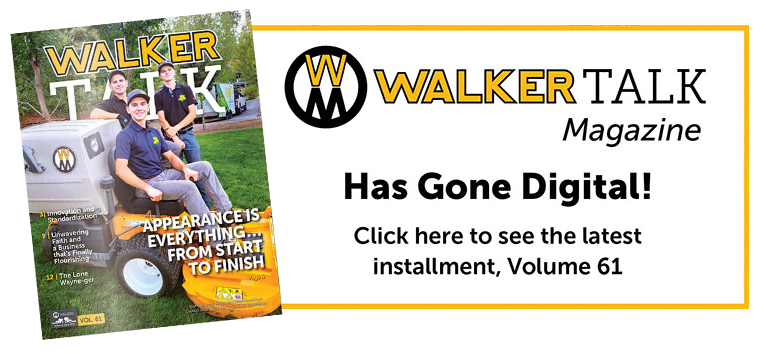More than a few lawn maintenance professionals and groundskeepers rely on used equipment either as front line workhorses or as dependable backups. When properly maintained and upgraded, used equipment can be nearly as effective as equipment fresh off the assembly line, at much less the cost. The kicker? If not approached with caution and more than a little up front knowledge, buying used equipment can end up costing the new owner more, much more, than he or she anticipated.
The following are a few guidelines prospective buyers of used equipment might want to consider before writing the check.
Give It The "Once-Over"
To borrow a cliche, having an opportunity to buy a used Walker mower can be like having money in the bank. These mowers are built to last and with just a little tender loving care and routine maintenance they can perform wondrously for thousands of hours of rigorous mowing.
If you're fortunate enough to find a used Walker, remember this: Like any piece of commercial mowing equipment, the Walker mower takes its share of punches. Although routine maintenance and the replacement of wear items will keep it running like new for years to come, the lack thereof will conversely compromise its ability to perform and decrease its overall value to the operator or the used equipment buyer.
Before purchasing a used Walker or any used mower, take a moment to give it a "once-over" inspection. If you are not comfortable judging the condition of mechanical components, it would be a good idea to have a qualified small engine mechanic help you make the inspection. While the following inspection items apply specifically to Walker Mowers, the general outline should be useful for other brands of riding mowers.
The following items represent the most expensive components and should be carefully checked:
Engine
• Compression • Spark plug (bad if oily or fouled) • Oil (dark oil or heavy sediment indicates poor maintenance) • Look for oil leaks • Check cleanliness of cooling fins and cylinder head shrouds on air-cooled engines. Check radiator fins on water-cooled engines • Check air cleaner: filter, baseplate, cover. Look for dust in carburetor throat indicating dust ingestion. Note: On 16 hp Kohler engine, check carburetor throttle shaft for wear.
Transmission(s)
• Transmission fluid should not be black, smell burned (overheated) or appear milky (water contamination) • Check cleanliness of cooling fins (especially underneath) and condition of cooling fans • Look for oil leaks on input shaft and control arm shaft.
Gearboxes
• Low oil or no oil is a red flag • Look for oil leaks • Check input/out put shafts for excessive play or backlash. Raise drive wheels and check axle for looseness.
In addition to the engine, transmission and gearboxes, a quick inspection of wear items will give you an idea of what will be needed and the overall cost to put the machine in top shape. Look at the following parts for wear: • GHS blower housing and impeller • GHS grass chutes (especially elbow inside catcher) • Deck caster wheel bearings and pivot bearings; also tail wheel bearings on tractor • Remove deck-it should slide freely off support arms. Check deck support arm pivot for excessive play. • All hoses (air, water, fuel) • Exhaust system (holes or leaks) • Drive belts and pulleys, check how belt fits in pulley to indicate worn pulley • U-Joints on PTO drive line for looseness • Mower deck housing, especially skirt and internal baffles • Battery • Tires • Electrical system; look for any "cobbled up" connection or "temporary" wires.
Running Test
The following checks are made for function: • Start engine- it should start easily • Allow engine to warm up, check acceleration off idle. Look for exhaust smoke, vibration or unusual noise as indications of problems • Check movement and function of all controls (throttle, choke, forward speed control, steering levers, clutch, parking brake) • Test all safety switches and safety latch on GHS catcher door • Drive the machine to warm transmission oil, then drive up against a wall or fence to check transmission power output. There should be enough power to slip both drive wheels • Operate PTO clutch and brake. Brake should stop blades 5 seconds after clutch disengagement • Check operation of Powerfil oscillating spout and Grass-Pak "full" signal inside catcher.
The effort to make a pre-buy inspection will pay. As the prospective owner, you first want to make sure to pay a fair price for the equipment you're buying and then have it perform to expectations when you get it home and in the field.
It's important, too, to buy from a reputable dealer or individual. In other words, buy from someone you know and avoid the possibility of buying stolen equipment. Remember, too, that dealers can provide training and they oftentimes guarantee equipment for a period of time. One last note, no matter who you buy your used equipment from, ask for the operator's manual. If it's not available, write to the manufacturer to obtain a copy.
Todd Poe and Bruce Miller, A & G Turf Equipment, Peoria, Arizona, contributed to these articles.





 Site Search
Site Search



